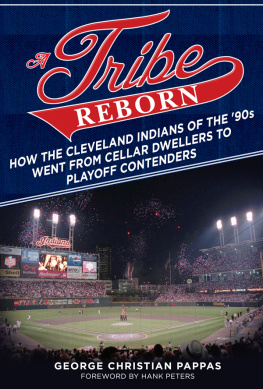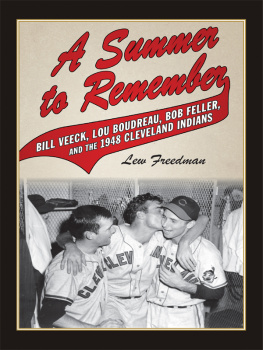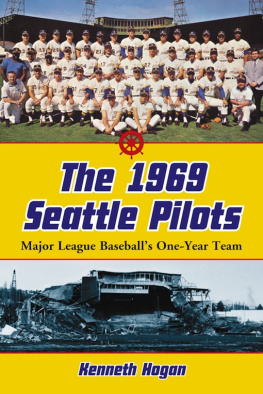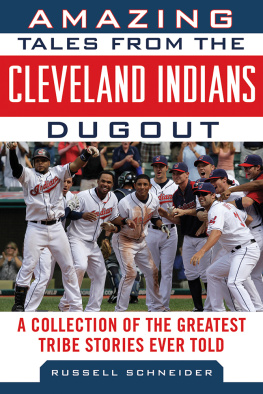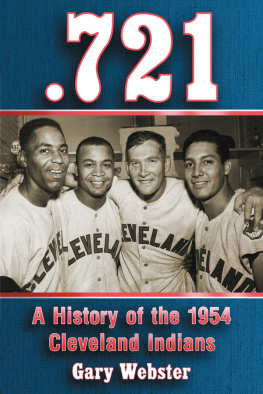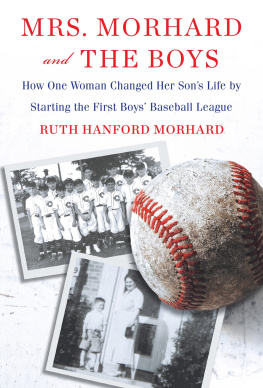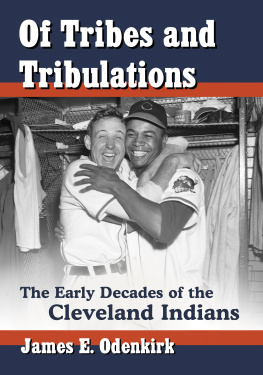Copyright 2014 by George Christian Pappas
Foreword copyright 2014 by Hank Peters
All Rights Reserved. No part of this book may be reproduced in any manner without the express written consent of the publisher, except in the case of brief excerpts in critical reviews or articles. All inquiries should be addressed to Sports Publishing, 307 West 36th Street, 11th Floor, New York, NY 10018.
Sports Publishing books may be purchased in bulk at special discounts for sales promotion, corporate gifts, fund-raising, or educational purposes. Special editions can also be created to specifications. For details, contact the Special Sales Department, Sports Publishing, 307 West 36th Street, 11th Floor, New York, NY 10018 or .
Sports Publishing is a registered trademark of Skyhorse Publishing, Inc., a Delaware corporation.
Visit our website at www.sportspubbooks.com
10 9 8 7 6 5 4 3 2 1
Library of Congress Cataloging-in-Publication Data:
Pappas, George Christian.
A tribe reborn : how the Cleveland Indians of the 90s went from cellar dwellers to playoff contenders / George Christian Pappas ; [foreword by] Henry J. Peters.
pages cm.
Summary: A Tribe Reborn tells the story of a failing franchise, from The Mistake by the Lake to The Curse of Rocky Colavito, and how a laughingstock team that was on the verge of relocating changed its ways to become a dominant franchise-- Provided by publisher.
ISBN 978-1-61321-637-8 (hardback)
1. Cleveland Indians (Baseball team)--History. I. Title.
GV875.C7P36 2014
796.357640977132--dc23
2013040401
ISBN: 978-1-61321-637-8
Printed in the United States of America
To my family: I would say something to the effect that you are my All Stars, but youre so much more than that. Im extraordinarily blessed to have you.
To the fans: 455 consecutive sellouts happened in Cleveland... first.
It [Cleveland] is a sleeping giant. It only needs to be reawakened. That wont come with words, only action. But give fans what they want, a winning team, and they will react like no other city has.
Gabe Paul, former Cleveland Indians executive, 1979
TABLE OF CONTENTS
PREFACE
M y grandmother Irene was nine years old the last time the Indians won the World Series.
Back then, she rode the streetcar to Municipal Stadium on Lake Erie, accompanied by her older brother, Hipp, and sister, Helen. The Cleveland of her youth was a special place. After all, it had been the home of the nations first traffic signal, the worlds first city to be fully lighted by electricity, and the birthplace of Superman and Life Savers candies. Industrialist John D. Rockefeller made his fortune there and spent his final years living in one of the palatial estates on Millionaires Row. Clevelands Symphony Orchestra was included in Americas elite Big Five classical ensembles, and its PlayhouseSquare Center was the nations second largest theater complex after New Yorks Lincoln Center. Cleveland was indeed special, and so was its Tribe. But after the Tribes last pennant in 1954, the city and its baseball team spiraled into four decades of decline. The Indians became perennial losers, the steel mills stopped producing, the city went bankrupt, and the mansions of Millionaires Row started to vanish. (Rockefellers manor was reduced to rubble to make room for a gas station and parking lot.)
Luckily for me, I was born in Cleveland just as the city and its baseball franchise were on the brink of their renaissance in the early nineties. I was treated to six divisional championships and two World Series appearances in the first eight years of Indians baseball that I can remember.
I learned to love the game of baseball from the left-field bleachers at Jacobs Field. It was a place where loud rock music pulsated over the loudspeakers, the aroma of hot dogs and Bertman original Ball Park Mustard drifted about the stadium concourse, and Slider, the Tribes pink, fuzzy mascot, bounced around among the fans. Sellout crowds packed the place, and we all got to watch players like Albert Belle, Carlos Baerga, Eddie Murray, Sandy Alomar Jr., Jim Thome, and Manny Ramrez launch towering blasts into the seats. Omar Vizquel dazzled with his glove at shortstop and Kenny Lofton stole bases with ease. This was Indians baseball and as far as I knew, it had always been that way.
Twenty years later, I look back at the Cleveland of the ninetiesthe Cleveland of my youthas a special place. Watching the Tribe back then made me a rabid fan to the point that I wore high socks and pointed my bat like Thome throughout my Little League days. I knew I wanted to spend my life around baseball, and here I am, working my way toward a career in a front office. They say your past experiences have a hand in shaping your future. The Tribe has played a major role in getting me to this point in my life; but its the former players, coaches, and personnelall of whom made me a fan in the first placethat continue to influence me, as they once did when they called Jacobs Field their home.
FOREWORD
T he history of the Indians is a mixture of success and failure. While the game as it is played on the field has changed very little over the years, how to run a club and be successful is constantly changing. The ownership of the Indians went through many changes from the mid-fifties until the Jacobs brothers bought the club prior to the 1987 season. The one thing that remained constant through all the changes was losing. That first year of ownership was not a successful nor happy one for the new owners. The losing continued, and they knew something had to be done or baseball would be dead in Cleveland.
When Dick Jacobs called me in late October of 1987 after my twelve-year run as general manager of the Baltimore Orioles had ended, he mentioned how hed like to talk about me possibly running the Indians. My first reaction was: Do I really want to do this? In order to understand my hesitation, you need to know two things:
1. I had spent six rather miserable years with the Indians from 1966 through 1971;
2. From what I knew about the current Indians, the organization was in bad shape, beginning with the playing personnel and extending to the front office and player-development program.
The task ahead was not one of rebuilding, but one of starting over from scratch.
The state of the Indians reminded me of my experiences with the Kansas City Athletics when I took a job there as farm and scouting director in January of 1955, after Connie Mack sold the Philadelphia As and the club had moved to Kansas City. At the time of the move, the club had one scout; no major-league prospects among the 96 players on the roster of four minor-league clubs that had no managers; and, finally, a last-place major-league club.
I would like to claim that I enjoyed immediate success in building the player development and scouting staff, but that was not the case. Funding needed to accomplish the task was limited. Progress in the early years was slow, except in building a scouting staff. We came up with a couple of future stars like Clete Boyer and Ken Harrelson, but not too many others.
When Charlie Finley bought the As in 1961, he was willing to provide the funding needed to make things happen. It was during this period from 19611965, when a solid scouting staff was in place, that the majority of the players who eventually became World Champions, after the As moved to Oakland, were signed and developed by the organization. This group included current Hall of Fame players Catfish Hunter, Rollie Fingers, and Reggie Jackson. While it took years to build a winner, progress can come quickly once you have developed a solid staff of talented, dedicated people; coupled with the funding required.

